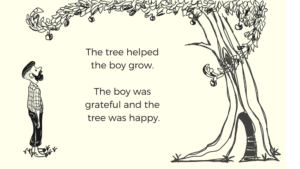Do you know the story of The Giving Tree?
Many of us do, either as a childhood story or as one that has been introduced to us as adults to share some life lesson or axiom.
The story goes like this …
A young boy finds a tree. The tree loves the boy, and they play. Then the boy grows older and wants things from the tree: its apples, branches, and eventually its trunk. The tree gives the boy everything, happily, until all is left is a stump. The end.
The full story is available here.
Ostensibly, this is a story about selfless giving, and business folk often hold it up as a wise allegory: a story of leadership to inspire managers into their own career of selfless servitude.
Huffington Post shares the story of The Giving Tree and says, “Great leaders put others’ interests first.” LeaderChat says, “Great leaders do the same with their employees—doing whatever they can to help employees feel valued and be successful.”
Y’all … I’ve been given this story as an example of what female leadership should look like, and the worst part is that in my younger years—I actually believed it.
Starting in people ops within nonprofits, servant leadership has always been part of my approach with employees and clients. I embodied The Giving Tree, drawing personal and professional meaning from making others happy, solving problems for them, and giving all I had 24/7.
This was great for a little while until … my people needed more apples and I was a stump.
It’s time to straighten out what we THINK we know about servant leadership and the lessons of The Giving Tree, because this is not the way to succeed.
What is Servant Leadership?
In the 1970s, Robert K. Greenleaf challenged the traditional ideas of a great boss operating with authority and power, and coined the term servant leadership. Greenleaf differentiated this new kind of leader, saying, “The servant-leader shares power, puts the needs of others first, and helps people develop and perform as highly as possible.”
I love this ❤️
If you define a selfless servant leader as something akin to The Giving Tree, then you’re actually engaging in an overcorrection of power from what Greenleaf intended, where the leader blindly adheres to the wants of others, without the focus of development. It also ignores that one of the most selfless gifts you can give someone is that of their growth and self-sufficiency.
Over time I realized this type of leader, while popular with employees, is not sustainable. Without the focus on development, managers rescue vs empower, and the cycle continues.
I saw this demonstrated not just in my career, but also in that of other female leaders I admired. It’s easy to fall into this pattern of appeasement in hopes to avoid conflict, increase employee engagement scores, or even dodge a negative Glassdoor review. It’s not necessarily that this path it easier; however, it is often the path of least resistance.
And so I started to interrogate my beliefs about what being a leader meant. I trusted that Greenleaf was on to something powerful, and yet my application of these principles was failing.
I came to a new realization: a true servant leader is like being a compassionate coach, someone who raises their people up to their full potential. It can be, and often is, uncomfortable.
You must be fierce, strong, and occasionally unpopular—which sometimes contradicts the expectations of a female leader. To me, having the courage and willingness to embrace this is selfless.
The Giving Tree, an Updated Story
I propose a new version of The Giving Tree…
The tree, instead of giving everything, helps develop the boy into a leader in his own right. The boy, while being served by the tree, becomes healthier, wiser, freer, more autonomous, and—in the end—more likely himself to become a servant leader.

This version of The Giving Tree is one of empowerment. It’s a story of success, both for the tree and for the boy. I believe this is the kind of growth we can expect from our teams and leaders. It starts with reframing how we define servant leadership.